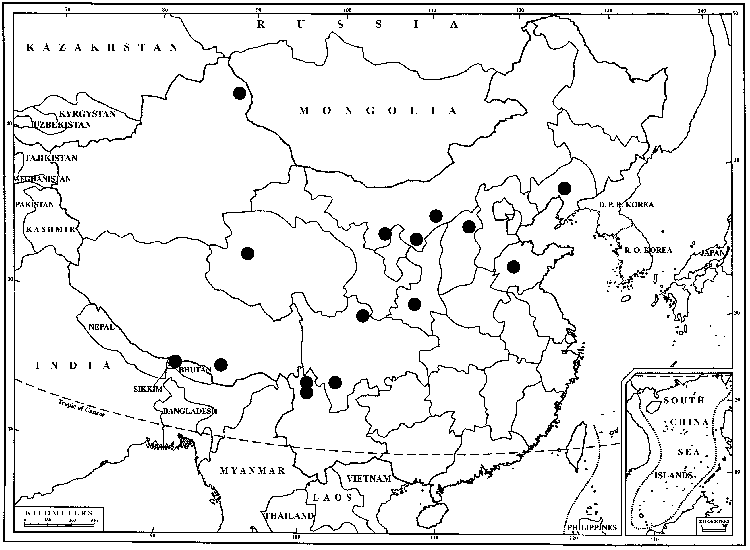Didymodon tophaceus
Elenc. Musch., 31. 1837,.
Plants green to olive green or tan. Stems to 1.5 cm, central strand present. Stem-leaves weakly spreading or rarely appressed when dry, spreading and often keeled when moist, monomorphic, ovate to long-elliptic but occasionally ovatelanceolate, adaxially grooved along costa or broadly channeled, 1–2 mm, base ovate, margins recurved in proximal 3/4 of leaf and often decurrent on stem, entire, apex broadly acute to obtuse or rounded, often in same collection, not fragile; costa percurrent or ending 1–6 cells below the apex, tapering or rarely spurred above, sometimes much broadened at the base, pad of cells absent, adaxial costal cells elongate at least in the central 2 rows, 4 cells wide at mid leaf, guide cells in 1 layer; basal laminal cells weakly differentiated medially, quadrate or shortrectangular, walls usually thickened; distal laminal cells 9–12 (–14) µm wide, 1: 1, papillae usually absent, rarely simple and 1–2 per lumen, lumens roundedquadrate or rounded, walls thin to thickened, weakly convex on both sides, 1-stratose. Specialized asexual reproduction specialized structures absent. Seta 0.7–1.2 cm. Capsule 0.6–1.5 mm; peristome teeth absent, rudimentary or short and 16, ligulate, cleft to near base, untwisted, to 220 µm. Spores 12–14 (–20) µm. Distal laminal KOH reaction red to orangebrown, occasionally yellowbrown.
Phenology: Capsules mature winter–spring.
Habitat: Limestone, limy shale, dolomite, cliffs, rock, moist areas, seepage, waterfalls, moist clay
Elevation: low to moderate elevations (0-2000 m)
Distribution

Alta., B.C., N.W.T., Ont., Que., Yukon, Ariz., Calif., Colo., Idaho, Ill., Iowa, Kans., La., Mich., Minn., Mo., Mont., Nev., N.Mex., N.Y., Ohio, Okla., Oreg., Pa., S.Dak., Tenn., Tex., Utah, Va., Wash., Wyo., Mexico, South America, Europe, Africa, Atlantic Islands, Pacific Islands (Lord Howe Island)
Discussion
Insufficient emphasis has been placed on the elongate cells of the adaxial costal surface of Didymodon tophaceus. The similar European D. sicculus Cano, Ros, García-Zamora & J. Guerra, with quadrate adaxial costal cells (M. J. Cano et al. 1996), should be looked for in the flora area. Although long leaf decurrencies are often considered characteristic of D. tophaceus, these are not always present. Being rather variable, this species is sometimes difficult to distinguish from the lanceolate-leaved D. fallax. It is commonly fruiting but absent from the Arctic. Like fellow calciphilic hygrophiles Hymenostylium recurvirostrum and Eucladium verticillatum, D. tophaceus is often encrusted with calcium carbonate; the broad leaves and often red costa help distinguish the latter. Barbula bolleana is quite like D. tophaceus but can be immediately distinguished by its large size, the 20–30 even rows of thin-walled, often papillose distal laminal cells with quadrate to short-rectangular lumens, and the peristome when present long and twisted, while D. tophaceus has 10–15 often irregular rows of usually thick-walled, usually smooth distal laminal cells with usually oval lumens, and a short peristome. The western D. nicholsonii has much the same leaf shape and hygrophytic nature but differs by the less decurrent leaves with 2-stratose margins or patches (or distally throughout), the smaller, more papillose laminal cells, which are red in KOH (D. tophaceus may be red-tinged but the laminal cell walls are yellow under the high-power lens), and the quadrate adaxial costal cells (in surface view). Because of its broadly rounded leaf apices, Barbula convoluta may be confused with D. tophaceus, but it is very bright yellow in KOH solution, has small, strongly papillose laminal cells, and is not hygrophilic.
Selected References
None.
Lower Taxa
"um" is not declared as a valid unit of measurement for this property."um" is not declared as a valid unit of measurement for this property.